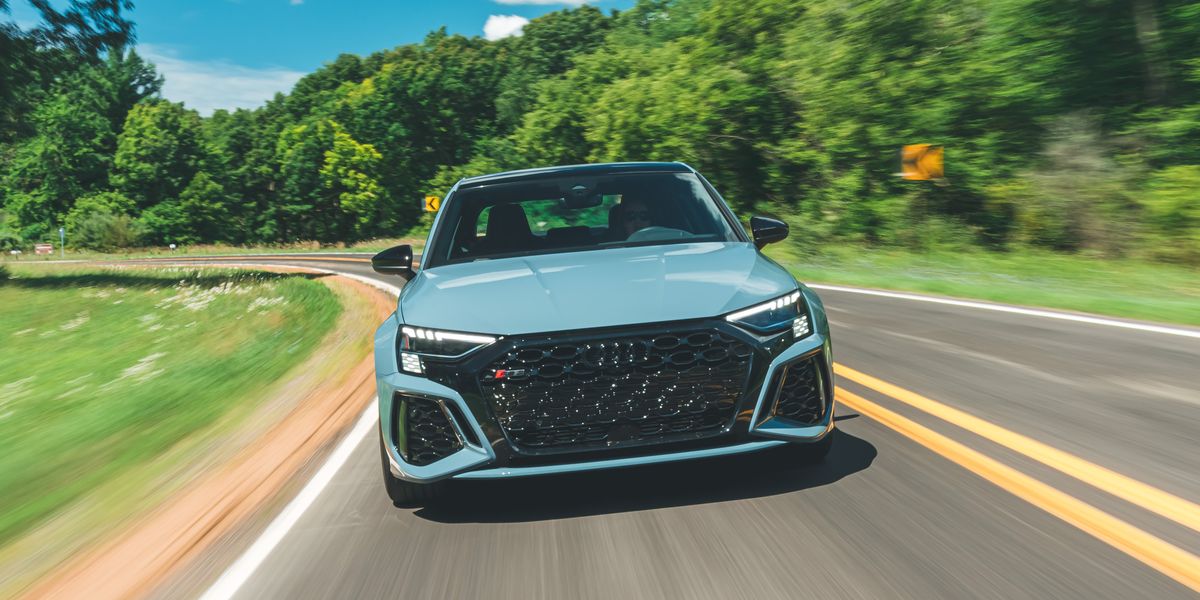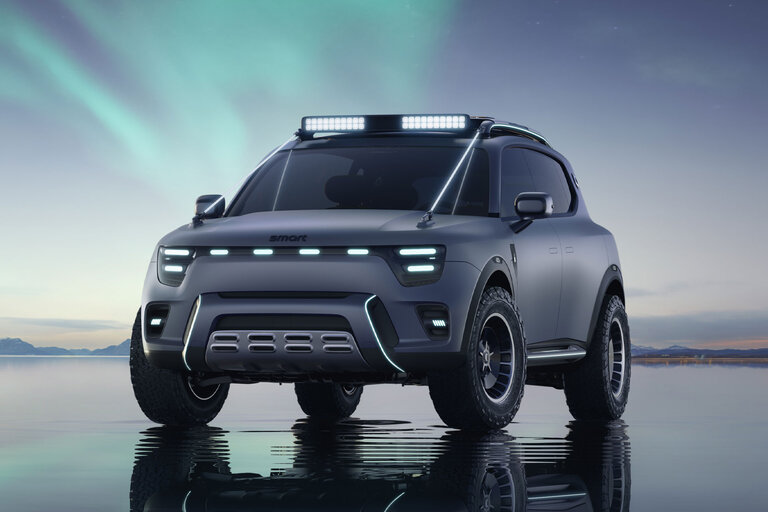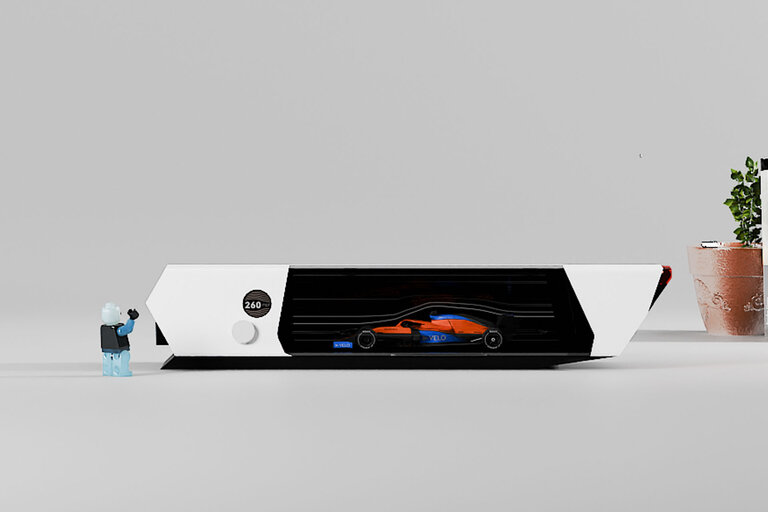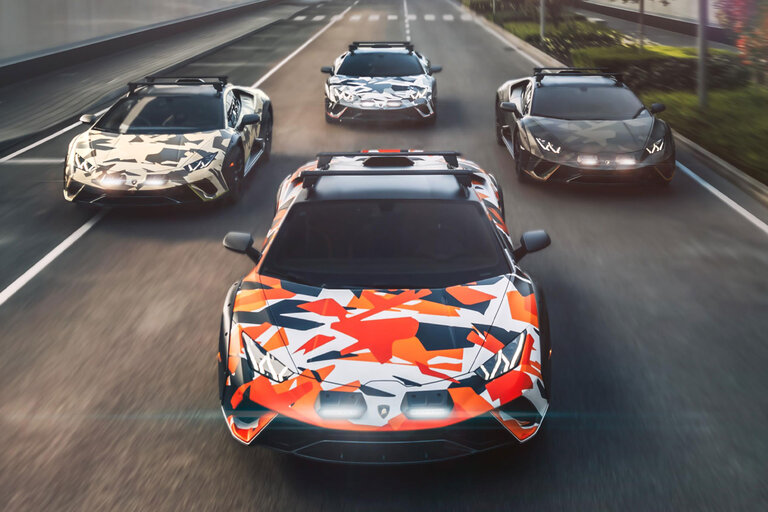
UPDATED 8/10/22: This review has been updated with test results.
Yes, the Audi RS3 has a drift mode. And yes, it allows even the most ham-fisted among us to participate in the sort of cackle-inducing hooliganism that was once exclusive to rear-wheel-drive cars. But really, the trick rear differential that the RS3 shares with the Volkswagen Golf R is of most benefit on the track, as the stocky sedan’s Nürburgring time of 7:40.8 convincingly suggests.
Though the genetics are undeniably obvious, the RS3 has been honed into an altogether different thing this time around, and it’s a lot more serious about extracting lap times. Its brutish looks send the message even before you drive it. Those uniquely flared fenders house 265-mm-section-width tires in the front and 245s in the back, up from the previous-generation RS3’s optional 255s and 235s, respectively. The people at Audi Sport put a lot of thought into making this thing turn. What you can’t see are the RS3’s specific spindles and hubs, front subframe, control arms, or anti-roll bars. Compared to the S3, the front track is two inches wider, and there’s an additional degree of front negative camber (along with an additional half degree of negative camber out back). So, if you were thinking you’d buy an S3 or a Golf R and do some mods here and there to make up the difference, you won’t.
Even if you got close, you’d still be down a cylinder and its half-liter of displacement—not to mention the 2.5-liter’s wonderful character. That Audi builds a five-cylinder at all probably should be celebrated, and this one’s good. Boasting a unique soundtrack and layout in defiance of this era of sameness, the weird and award-winning engine is turbocharged to 401 horsepower and 369 pound-feet—seven ponies more than in the previous model but 15 additional pound-feet. There’s a little turbo lag at low rpm—it’s nothing egregious, just not the tons-of-torque-right-now tune you’re familiar with from the brand’s boosted four-cylinder engines. In any case, the slight lull is more than made up for in the run to redline, where the RS3 pulls and pulls . . . and pulls . . . and pulls . . . until the upshift.
A seven-speed dual-clutch automatic is the only transmission offered. It’s beefier than the unit in the S3 and shares not a single gear ratio. We caught it a little behind the ball on downshifts more than a few times—it’s best to use the Manual mode if you’re chasing lap times. From there, an open differential sends torque to the front wheels as before, while at the other end of the prop shaft, two independent clutch packs replace the previous single Haldex clutch. By de-clutching the inside rear wheel, the system can effectively direct the rearward torque to the outside wheel, helping to mitigate understeer or instigate the aforementioned drifting antics in the RS Performance drive mode. As before, the front wheels are driven all the while.
With launch control engaged, our 3639-pound test car shot to 60 in 3.3 seconds, beating the 2017 RS3 we last tested by a tenth of second, despite the new version weighing 92 pounds more. Stay in it, and the quarter-mile flies by in 11.8 seconds at 117 mph. However, the magic of the dual-clutch’s launch-control programming combined with the engine’s higher torque peak—3500 rpm versus the old RS3’s 1700 revs—are evident in the run from 5 to 60 mph, which at 4.7 seconds is actually o.4 second slower than before.
In practice, the RS3’s mechanical trickery provides the best of both worlds. If you dive into a corner with too much speed, trusty understeer allows an easy save. Alternately, approximate the right entry speed (which for this car is a little hot), punch the gas sooner than you think you should, and let the electronics shuffle torque and pull you out. It pays to drive the RS3 with ham-fisted aggression.
The steering wheel is just the right thickness and offers precise control. The sheer width of the front tires is easy to discern even through the damping of the electric steering rack, translating to your palms as “brute steamroller,” not “nimble little sedan.” Your job is to confidently yank the wheel, mash the gas, and move on to the next corner. Unfortunately, grip levels have dropped slightly compared to the old RS3, at least on the standard Pirelli P Zero PZ4 summer tires that our test car wore. Around the skidpad, the new RS3 stuck to the pavement at 0.94 g versus the 0.98 g that the 2017 model generated on similar Pirelli tires. Likewise, its 167-foot stop from 70 mph on the standard iron rotors is 10 feet longer than we previously saw from the optional carbon-ceramic setup. To combat this, Audi now offers track-oriented Pirelli P Zero Trofeo R rubber as a $450 option.
If you’re going to take your RS3 to the track—and you should—you’ll probably find its setup to be a fair compromise. The suspension seems perfectly damped for road driving, which is a feat given its competence on the track. In Comfort mode, the rebound feels exactly in sync with undulations and depressions, particularly at high speeds; in the most aggressive Dynamic setting, we found the dampers to be overly stiff for use on ragged Midwestern roads. Configure the car’s RS Individual mode accordingly.
The RS3 starts at $59,995. It’s well-equipped as it sits, but there are several temptations, from the $5500 Dynamic Plus package (lighter carbon-ceramic front brakes, elevated 180-mph top speed) to the $2750 Tech package (better navigation, traffic-sign recognition, Bang & Olufsen audio, and a head-up display). We do recommend the $1000 RS Sport exhaust—the better to hear the 88-decibel warble of the turbo five-banger—and if you wanted to, you could price your RS3 into $70K-plus territory. But we hardly think that’s necessary to enjoy what this rowdy little car brings.
Is the RS3 worth it? There’s no question this car has been painstakingly optimized for track duty, and the level of attention is rare at this price point. Set up an S3 as close as you can and you’re still spending $50,000. BMW’s redesigned M2 has yet to appear, and the Mercedes-AMG CLA45, while very similar in price, has one less cylinder and isn’t quite as serious about turning laps at the track. For the right person, the RS3 might be a value. And even if you’re not down with cutting loose on the racetrack, you’re still buying five-cylinder exclusivity.
This content is created and maintained by a third party, and imported onto this page to help users provide their email addresses. You may be able to find more information about this and similar content at piano.io
#Audi #RS3 #Hits #MPH #Seconds
Source link





